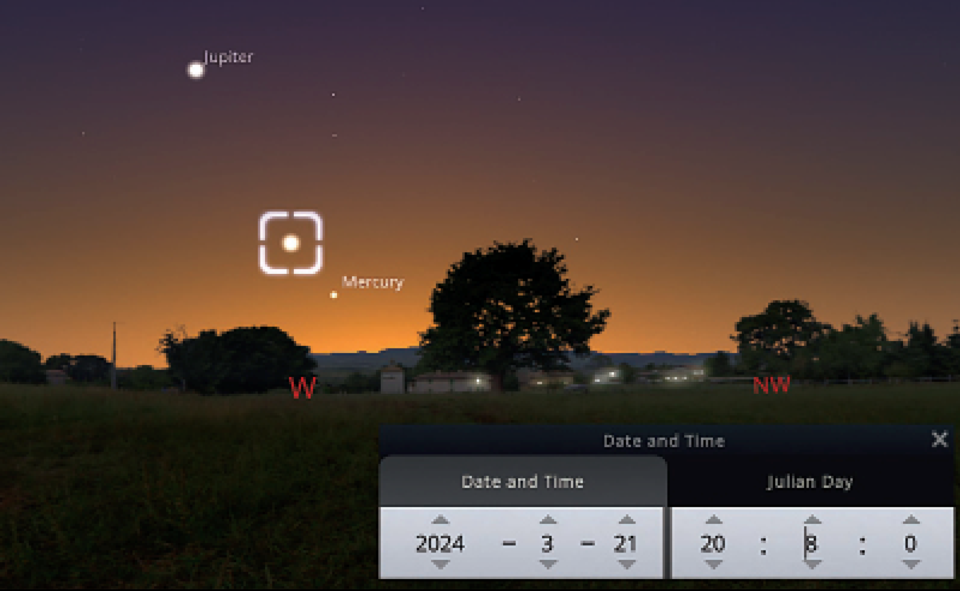There is a morning series of International Space Station (ISS) passes through March 8, followed by evening passes through the rest of the month. Check the Heavens-Above website for info on these. Also, for purposes of clarification – and I should have mentioned this in 2019 when I started writing these articles – any of the Stellarium screenshots showing what can be seen are based on the following location: 49° 27’ 37” N, 123° 42’ 49” W. This is the rounded-off location of the club observatory up Field Road at the Sechelt aerodrome.
Just after midnight on March 2, the star Antares – the bright one in Scorpio – will reappear from its occultation by the moon. These events are not that common, since they only occur for bodies on or near the ecliptic, which is the path through the sky of the major solar system objects. In this case, the sunlit limb of the moon occults the star at 23:17 on March 2 and it reappears from behind the dark limb at 23:02. The problem for us will be that the moon doesn’t rise until 02:30 on March 3, so it all occurs just below the eastern horizon. One of the drawbacks of local life.
On March 10, the moon does its closest approach to Earth for the year (perigee) at 356,894 km, beating the one in October by about 280 km. Remarkably, this occurs within two hours of new moon, when moon and sun are almost exactly colinear with Earth. Result: very high tidal ranges. Other factors also influence this – distance to the sun, the season, and the size and shape of our body of water – but it’s still a major factor. I propose, similar to naming last month’s apogee full moon an UnSuper Moon, that we call this a Super UnMoon. Seems logical to me anyway.
Jupiter’s moons are also nice and close to the planet high in the southwest on the evenings of March 10 and 11, if you have a telescope that can resolve them (or good binocs and REALLY steady hands.) By March 13, a crescent moon passes Jupiter and very low in the west, we begin a series of appearances of Mercury. By about 20:00, it will appear to climb up and left each evening until its furthest eastern elongation from the sun on March 24. It then begins to swing around this side of the sun, growing in apparent size but becoming less visible. It becomes a crescent and reaches inferior conjunction (between us and the sun) on April 11. This will be the best apparition for us in the Northern Hemisphere for 2024. Contingent on available space, the Coast Reporter wizards may be able to include a small Stellarium screenshot of the western horizon just after 20:00 on March 21, showing Jupiter about 30 degrees above the horizon and Mercury about 10 degrees, below and right of Jupiter. There should also be a good view of the ISS (highlighted) rising and passing between the two; check Heavens-Above for exact times.
Another possibility for March is that Comet 12P Pons-Brooks, inbound from the outer solar system, is approaching perihelion on April 24. Its magnitude as of Feb. 26 was 6.5, which is just below naked eye visibility, but the comet should brighten as it approaches, possibly to magnitude 4.5 on this trip. According to Wikipedia, the comet’s nucleus is about 30 km diameter or so and they describe it as Halley-like, presumably because of its size and orbital period of about 70 years, which gets it out as far as Neptune, a distinctly chilly neighbourhood. It should soon start being visible with binoculars in the northwest after sunset, moving up and left through Andromeda. Its perihelion distance is over 100 million km though, just outside the orbit of Venus, so it shouldn’t be subjected to extreme heat that might cause something spectacular. No Hale-Bopp or Neowise light show this time, folks, I’m afraid. The best rule to remember, though, is that comets are like cats: they have tails and they’re utterly unpredictable. Info is readily available from the Heavens-Above website.
Ongoing efforts to recover from the recent tsunami at the Sechelt Library mean the SCAC monthly meeting will instead be held at the Sechelt Seniors Activity Center at 7 through 9 p.m., Friday, March 8. The speaker will be John Kavelaars on: New Horizons Mission to Pluto and beyond. Please check the club website at: https://sunshinecoastastronomy.wordpress.com/ for news.



